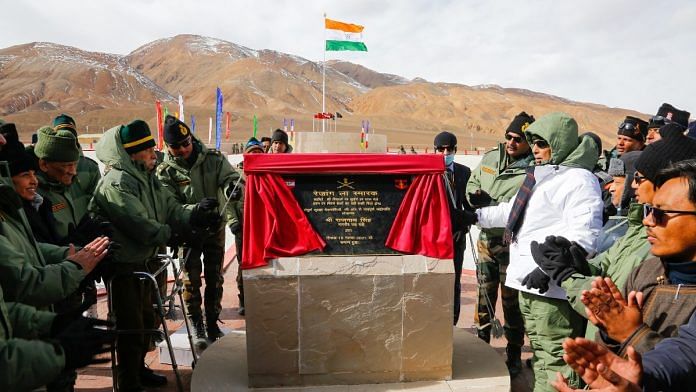New Delhi: The Battle of Rezang La, fought between Indian and Chinese troops on the icy mountain tops on the southeastern ridge of the Chushul Valley, is often remembered as a show of great Indian strength during the war in 1962.
Not the kind of strength to be understood in terms of military preparedness or tactical prowess — Indian troops were severely outnumbered, weren’t as well acclimatised to winter conditions as their Chinese counterparts, had inferior weaponry and more importantly, the heights of mountain tops interfered with the flight of artillery shells. That said, the soldiers of the Charlie Company of 13 Kumaon demonstrated the kind of strength it takes to fight till ‘the last man, last round’ on that chilly night of 18 November, 1962.
Of the 120 men and officers of this company, 114 died. Yet they managed to inflict over 1,000 fatalities on the enemy side.
This appears all the more impressive when we take into account that all the soldiers in the company, save for their commander who was a Rajput, were Ahirs who hailed from Gurgaon and Mewat region of Haryana, and came from communities of cattlemen and farmers. For them, serving in minus 30 degree temperature was a first and most had seen no active operations except in Jammu and Kashmir.
Perhaps this is what makes the Charlie Company of the 13 Kumaon battalion the most decorated company in the history of the Indian Army, as noted by author Kulpreet Yadav.
“One Param Vir Chakra, eight Vir Chakras, four Sena Medals and one Mentioned-in-Dispatches were awarded to the soldiers of the Charlie Company, making it one of the highest decorated companies of the Indian Army to this day,” Yadav notes in his book, ‘The Battle of Rezang La’.
Despite the fact that almost the entire company was wiped out in battle, they had put up enough of a fight to ensure that Chushul wouldn’t fall into Chinese hands. The 13 Kumaon regrouped and the 114 Brigade held on to Chushul, and on 21 November, the Chinese announced a unilateral ceasefire.
Also Read: From clash at Longju to ‘Operation Leghorn’, how skirmishes built up to 1962 India-China war
A mountain of challenges
Apart from being outnumbered, Indian troops faced a mountain of challenges. They are documented to have struggled with the harsh climate of the battlefield, which was located at an average height of 1,600 ft with the pass itself as high as 16,420 ft. They also faced difficulty digging defensive positions.
As Colonel N. N. Bhatia (retd.) notes, Indian troops were at a disadvantage due to the high crests of the mountain tops which gave them no artillery support and paucity of anti-personnel mines to halt the advancing enemy.
They also had few automated digging tools, antiquated .303 single shot bolt action rifles dating back to World War II, and old 62 radio sets that did not communicate due to frozen batteries, wrote Bhatia.
Meanwhile, the Chinese had 7.62 self-loading rifles, their troops were mostly locals from Singkiang region who were acclimatised to the harsh terrain and they actively spread their maps and carried out reconnaissance, he adds.
“What if these brave soldiers had better guns, more ammunition, adequate snow clothing, full stomach food, artillery support and able leaders at the army headquarters and in the government?” Yadav writes in his book.
Major Shaitan Singh
It would be erroneous to talk of the Battle of Rezang La without mentioning Major Shaitan Singh, the commander of the Charlie company who received the Param Vir Chakra.
When the Chinese soldiers attacked his platoons, he moved from one post to another to sustain the morale of his troops. This came at great personal risk as he was first hit by enemy fire on his arm, and later struck in the abdomen after which two of his troops pulled him behind a boulder to take shelter, Yadav notes in his book.
Months later, his frozen body was found near that boulder along with scores of bodies of his troops. In February 1963, an Indian search party unearthed the snow-covered corpses on the battlefield, some still clinging onto their guns and others frozen to death in crouched positions.
The body of Major Shaitan Singh was flown to Jodhpur and cremated with full military honours.
How dog turned saviour
On the Indian side, five soldiers were taken as prisoners of war by Chinese forces. Among them was platoon commander Naib Subedar Ram Chander, who was taken prisoner while unconscious and released six months later.
There was also the curious case of Havaldar Nihal Singh, who managed to escape a day after he was taken in by the Chinese soldiers.
“The soldiers who took me in custody were walking around and talking. By then it became dark and it occurred to me that I should run. I slowly sneaked out from there. When I walked almost 500 metres, they fired three shots in the air,” Singh recalled in an interview fifty years later.
Other accounts note that Singh remembers coming across a dog while escaping, and it was the scruffy canine that led him to the battalion headquarters.
“In October, when the Charlie Company had arrived, they had fed this dog on a few occasions. The dog looked at him and started to walk in a particular direction. Sep. Nihal Singh followed the dog and after a few hours, he reached the battalion headquarters,” Yadav writes.
He adds some, however, believed the soldier could have been hallucinating, as he had at the time been severely injured in battle, with both hands bleeding out, and was battling harsh winter conditions.
(Edited by Anumeha Saxena)
Also Read: Walong: How Army held off a massive Chinese onslaught & launched only counterattack of 1962 war



